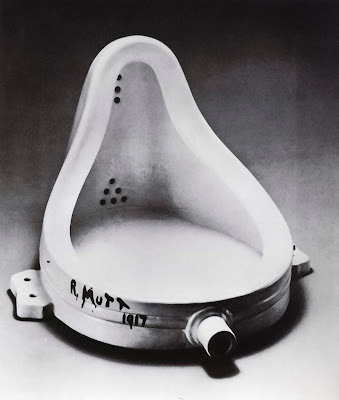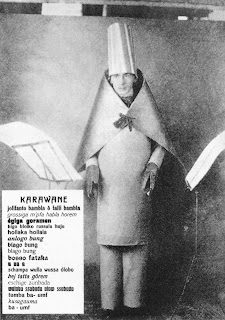 |
| Fountain by Marcel Duchamp (French); 1917; assisted readymade. Location: London, England; Tate Modern. Image via Angel Alcalá Brand. |
 |
Duchamp began an artistic revolution, creating readymade art from found objects (also referred to as found object art or objet trouvé). Duchamp created a piece of ready-made art for an exhibition in 1917 entitled Fountain, which was a urinal he purchased and placed on it's back. He signed “R. Mutt 1917,” but the piece was rejected by the exhibit; Duchamp waged a public protest.
 |
| L.H.O.O.Q. by Marcel Duchamp (French); 1919; assisted readymade. Location: Paris, France; Musée National d'Art Moderne. Image via Scott Zagar. |
 |
Hugo Ball was another kind of artist in the Dada movement. An author and poet, Ball felt that because paintings were phasing out human forms it was natural that poetry should reject the use of language.
 |
| Hugo Ball reciting the sound poem Karawane at
Café Voltaire in Zürich, Switzerland (1916).
Image via Study Blue. |
 |
The Dada movement, spread from Zürich to Berlin, New York, Tokyo and elsewhere. The Dada movement was the starting off point for other movements to follow, like surrealism abstract expressionism, performance art, conceptual art, and pop art. As important as Dada was for opening the door to these movements, it died out within a decade.
The Casino in Miami, Florida - DRMCD
ReplyDeleteThe Casino at Miami, Florida: Casino 대구광역 출장샵 with Slots 경산 출장샵 - The casino 부천 출장안마 offers 춘천 출장샵 2,000 충주 출장마사지 slot machines. The slots are all located in the casino floor.